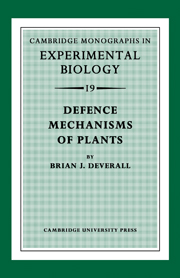Book contents
- Frontmatter
- Contents
- Preface
- 1 INTRODUCTION TO THE HOST–PARASITE INTERACTION
- 2 DISCRIMINATORY EVENTS BEFORE AND DURING PENETRATION INTO PLANTS
- 3 CYTOLOGICAL CHANGES IN HOST AND PARASITE AFTER INFECTION
- 4 CROSS-PROTECTION AND INDUCED RESISTANCE
- 5 PHYTOALEXINS AND THEIR INDUCED FORMATION AND BIOSYNTHESIS
- 6 ROLE OF PHYTOALEXINS IN DEFENCE MECHANISMS
- 7 MEDIATION OF HOST–PARASITE SPECIFICITY
- References
- Index
4 - CROSS-PROTECTION AND INDUCED RESISTANCE
Published online by Cambridge University Press: 10 May 2010
- Frontmatter
- Contents
- Preface
- 1 INTRODUCTION TO THE HOST–PARASITE INTERACTION
- 2 DISCRIMINATORY EVENTS BEFORE AND DURING PENETRATION INTO PLANTS
- 3 CYTOLOGICAL CHANGES IN HOST AND PARASITE AFTER INFECTION
- 4 CROSS-PROTECTION AND INDUCED RESISTANCE
- 5 PHYTOALEXINS AND THEIR INDUCED FORMATION AND BIOSYNTHESIS
- 6 ROLE OF PHYTOALEXINS IN DEFENCE MECHANISMS
- 7 MEDIATION OF HOST–PARASITE SPECIFICITY
- References
- Index
Summary
Cross-protection is the phenomenon whereby a plant is protected from infection by earlier or simultaneous exposure to another organism. This chapter will be concerned with protection against fungal and bacterial parasites as a result of infection by related and unrelated fungi and bacteria and of local lesion formation by viruses. It will not be concerned with the interference of the development of viruses by related or unrelated viruses (Matthews, 1970).
For a long time people have been interested in the idea that plants, like animals, can acquire physiological immunity to pathogens. Research, mainly in Europe in the late part of the nineteenth century and in the early decades of this century, was inspired by observations which suggested that some perennial plants were less severely affected by a disease following earlier infection. For example, the varied development of powdery mildew infections on the foliage of oak trees Quercus spp. in successive seasons had intrigued early investigators. Experiments had also been performed which seemed to show that herbaceous plants became more resistant to infection after the plants or the soil bearing them were sprayed with the extracts of fungal cultures. Numerous observations and claims of this type were reviewed by Chester (1933) who criticized the lack of sufficient replication for proper appraisal of the experiments and the frequent inadequacy of controls. Sources of error which had rarely been eliminated before drawing conclusions were losses of virulence in the parasites during experiments, differences in environmental conditions on successive occasions for assessing resistance, and natural increases in resistance as plants aged during the periods of supposed acquisition of resistance.
- Type
- Chapter
- Information
- Defence Mechanisms of Plants , pp. 30 - 42Publisher: Cambridge University PressPrint publication year: 1977
- 1
- Cited by



